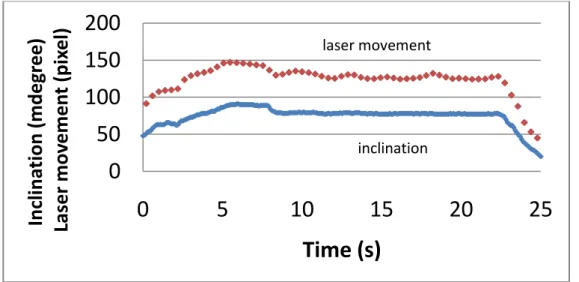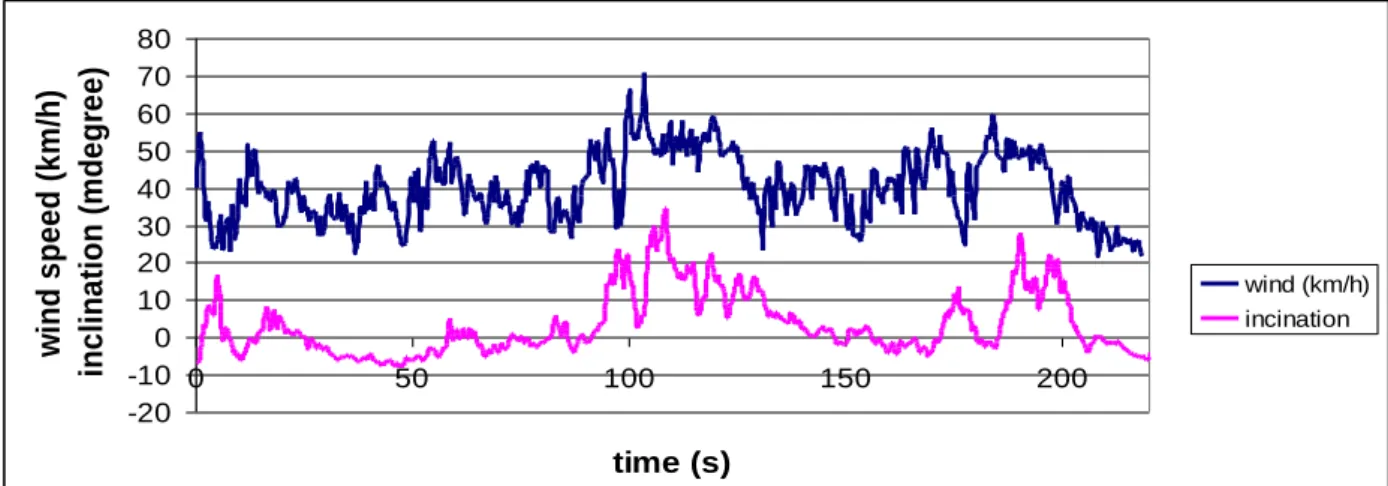1
STABILITY OF TREES
RESEARCH ON THE SAFETY OF BRANCHES AND ROOTS
Ágnes Kinga Buza
Sopron 2016.
2
Introduction
The aim of the research presented in this paper was to develop and test new nondestructive methods for tree safety. The focuses were developing optical methods and the comparisons of them to the already tested and used measurements. Researches have been done on braches and root stability.
There are many possibilities to estimate the safety of a tree’s trunk, while only a few measuring equipment can be used for estimating branches. These were developed for trunks. For example, the acoustic tomography can be used for bigger branches too. So the safety of branches was one of our focuses, because break away branches can also cause damages or injuries. The aim was to develop an optical system to estimate the safety of a branch.
In the other hand, there is only one method to estimate the root system’s stability which gives us useable information. This is the
“inclino” type pulling test. During this test a pulling cable is put on the tree and anchored near to the ground, while the pulling force is measured by a transducer. At the bottom, near to the soil an inclinometer is measuring the vertical leaning of the trunk. The pulling test uses a static force. The aim of the work was to turn the static measurement to a dynamic one. See whether the pulling cable could be changed to real wind. Another aim was to raise the resolution of the detection of the inclination. The inclinometer could be changed by a laser.
3
Evaluation of safety based on acoustic root mapping was done as well.
For estimating the safety of the tree the calculation uses the drag factor of the tree. The most of the drag factor data were measured in places where the wind is basically constant. This is why measuring the drag factor in wind gusts was also an aim of the work.
Materials and methods
The used materials and methods were quite different for the system used for measuring the branches and the other one used for measuring the trunks.
For the branches their movement was followed and the data were evaluated to get the natural frequency of the movement.
Perpendicular markers were put onto the tree, and the movements of them were measured by two cameras. The calculations were made by computer programs. Focusing on safety of branches, damage was simulated by cutting them and measurements were made during it.
The measurements were done by the following steps:
1. Choosing a branch, putting on the markers
2. Recording made by the cameras (in .mov files, 30 frames/minute)
When the damage was simulated the following steps were added to the measurement:
4
2a. Making a record of the movement of the non-damaged branch
2b. Making a small cut (a few mm deep) on the branch 2c. Recording the movement of the damaged branch
2d. Making a deeper cut, and recording the movement again.
Steps 2c. and 2d. were repeated till the branch was broke down or till the branch reached the ground and no more sway could be detected.
3. The record was opened and analyzed in the program MarkerTracker2, and Fourier-transformation was done in Microsoft Excel (with “Analysis ToolPack”). Plotting the curves of the data, and finding the natural frequency were also performed.
The estimating the root system’s stability a laser, a detection screen with web camera and a wind measurer was used. For comparison purposes the “inclino” type pulling test was done with cables, dynamometer and inclinometer.
The laser light source was fixed on the trunk at bottom height, just like the inclinometer should be fixed. The laser beam was directed to a detecting screen attached to a web camera. For better resolution the screen was put as far from the laser source as it could be. “Inclino”
type pulling test and following of the laser movement were performed parallel. Real wind measurements were done as well.
Acoustic root maps were draw and a new calculation of evaluation of safety was set up.
5
Results and conclusions
The main goals were fulfilled during the work.
An optical system to detect the movement of the branches was developed and tested successfully. The tests show that the branches’
movement can be followed clearly and the movement can be evaluated.
Research on the safety of branches started. After successful tests, cutting simulated damages on branches. Examination of the response of branches showed significant changes if the branches were cut either from top or bottom sides. The data showed that the wood properties are different in the branch’s top and bottom sides. Ultrasound measurements were done to test this phenomenon. The results verified the differences. Tests were also made by cutting a homogenous wooden stick. This measure also verified the results above.
Damage causes different phenomenon depending on the place of the damage in comparison of the movement of the healthy, non- damaged branches.
The cut from bottom side makes just a very small change in natural frequency while the baseline of the movement is decreasing during swaying. Cut from top side effects the natural frequency which goes down significant. (Figure 1.)
6
Figure 1 – 3 typical frequency change curves.
Figure 2 –The movement of the laser dot and the measured inclination. Smaller movements are detectable only with the laser
system.
0 50 100 150 200
0 5 10 15 20 25
Inclination (mdegree) Laser movement (pixel)
Time (s)
laser movement
inclination
7
Experimental results show that the laser dot inclination measurement gives data which are equivalent to data collected by the inclinometer. Figure 2 demonstrates the similarity of measurements.
The laser movement seems to be more sensitive than the inclinometer.
Note that the new type of determination of trunk inclination is given by pixels; however, these data can be easily converted into micro- degrees.
Measuring in real wind could be used instead of the pulling test.
For this measure a fast wind measurer is need. The time resolution of the wind measurement should be more than 1Hz for detecting wind gusts. (Classical cup anemometers are too slow.)
During the measurement we could not find any connections between the movement of the trunk and the wind velocity in 10 meters for trees in stand. For free standing tree which is not covered from the direction of the wind the connection was found. The movement of the trunk followed the wind by a few seconds lag. (Figure 3)
Figure 3 — Wind speed and trunk movements. In this case the movement was measured only by the inclinometer.
-20 -10 0 10 20 30 40 50 60 70 80
0 50 100 150 200
time (s) wind speed (km/h) inclination (mdegree)
wind (km/h) incination
8
For the free standing tree (which was a horse chestnut tree, Aesculus hippocastanum) the drag factor was calculated. The movement of the trunk and the wind velocity was measured. For calibration purposes an “inclino” type pulling test was also done. The calculated drag factor (0.302±0.049) is not far from the data found in literature (0.35). Note that the generally used data are measured in places where the wind is basically constant. So the data calculated from our measurement of the drag factor made by wind gusts did not expected to be exactly the same. Using this drag factor the cable pulling could be replaced by real wind.
Results according to root mapping are modest. Safety evaluations were done for different trees with root mapping and pulling test. The estimated stabilities were much lower for root mapping. However, the ratios of the safeties of the different tree were nearly the same with both measures. The calculation model should be improved.
Summarizing the new scientific results
1. The movement of the branches can be followed by the optical system which was developed. The natural frequency can be calculated from the movement data. The calculation includes also Fourier- transformation.
9
The data of the movement and the natural frequency are specific for each branch.
The natural frequency was the same in wind and by pushing (on young/small branches in case of low winds).
2. Examination of the response of branches to dynamic load resulted significant changes if the branches were cut either from top or bottom sides.
Different damages were simulated by cutting the branches. In case of cutting from bottom side the natural frequency of the examined movement changed only a little. While the baseline of the movement decreased. In case of cutting from top side the change in natural frequency could be reported.
To understand these differences check measurements were done. The conclusion is as follows: there is difference between the wood properties in the top and bottom sides of the branches.
3. During pulling test the inclinometer can be replaced by laser movement detection.
Fixing a laser light source on the trunk at bottom height, just like the inclinometer should be fixed, the movement of the laser dot can be detected on a screen. From these movement data inclination can be calculated.
In the inclinometer a bubble is moving and causing changes in capacitance. This movement is slower than the movement of the laser
10
beam. The inclination resolution of the laser movement detection can be higher than the inclinometer’s.
4. Connection between the wind speed measured at 10 m height and the movement of the bottom of the trunk was found in case of free standing tree. When the trees were part of a stand the connection could not be found. The movement of the trunk did not show effect according to the wind gusts for trees in stand.
In the case of free standing tree the movement of trunk followed the wind gusts.
5. The drag factor of a tree could be calculated by measuring in real wind (if the anemometer is fast enough to detect wind gusts) and by a pulling test for calibration. This measurement and calculation was done for a horse chest nut tree (Aesculus hippocastanum).
6. The safeties evaluated with root mapping are lower than the ones evaluated with pulling test. The ratios of safeties of different trees are nearly the same. Correlation between the areas reached by the main roots (which ones could be found by root mapping) and the safeties may be stated.
11
List of publications
2016.
In press:
Buza A. K., Divos F. Root stability evaluation with non-destructive techniques
Acta Silvatica et Lignaria Hungarica
2015.
Buza A. K., Göncz B. 2015. Comparison of trees and NDT methods Wood Research. 60(1): 45-58.
Buza A. K., Divos F. 2015. Wood density measurement by microwave 19th International Nondestructive Testing and Evaluation of Wood Symposium Proceedings. 192-196.
Rio de Janeiro, Brazil, September 22-25.
Buza A. K. 2015. Static and dynamic root stability evaluations with inclinometer, and the examination of the roots [Hungarian: A gyökér stabilitásának vizsgálata statikus és dinamikus dőlésméréssel, valamint a gyökérzet vizsgálatával]
Faipar 63:3 15-23.
12
2013.
Divos F., Buza A. K. 2013. Micro-movements of trees
18th International Nondestructive Testing and Evaluation of Wood Symposium Proceedings. 92-98.
Madison, WI, USA, September 24-27.
2011.
Buza A. K., Divos F. 2011. Dynamic measurements on branches – link with stability
17th International Nondestructive Testing and Evaluation of Wood Symposium Proceedings. 207-211.
Sopron, Hungary, September 14-16.

